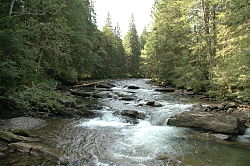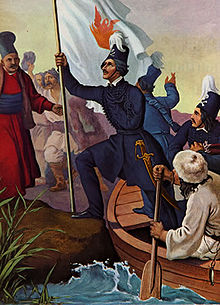Prut
| Prut Porata, Pyretus | |
|---|---|
 Prut River nearHoverla,Ivano-Frankivsk Oblast | |
 Map of the Prut River | |
| Location | |
| Country | |
| Oblasts/ Counties/ Districts | Ukraine: Romania: Moldova: |
| Cities | |
| Physical characteristics | |
| Source | Carpathian Mountains |
| • location | Mt.Hoverla,Ivano-Frankivsk O.,Ukraine |
| Mouth | Danube |
• location | Giurgiulești,Romania/Moldova |
• coordinates | 45°28′8″N28°12′28″E/ 45.46889°N 28.20778°E |
| Length | 953 km (592 mi) |
| Basin size | 27,540 km2(10,630 sq mi) |
| Discharge | |
| • location | mouth |
| • average | 110 m3/s (3,900 cu ft/s) |
| Basin features | |
| Progression | Danube→Black Sea |
| Tributaries | |
| • right | Cheremosh,Jijia |

| |
| Official name | Prut River Headwaters |
| Designated | 20 March 2019 |
| Reference no. | 2395[1] |
ThePrut(also spelled in English asPruth;Romanian pronunciation:[prut],Ukrainian:Прут) is a river inEastern Europe.It is a lefttributaryof theDanube,[2][3]and is 953 km (592 mi) long.[4]Part of its course formsRomania's border withMoldovaandUkraine.
Characteristics
[edit]The Prut originates on the eastern slope of MountHoverla,in theCarpathian MountainsinUkraine(Ivano-Frankivsk Oblast). At first, the river flows to the north. NearYaremcheit turns to the northeast, and nearKolomyiato the south-east. Having reached the border between Moldova and Romania, it turns even more to the south-east, and then to the south. It eventually joins theDanubenearGiurgiulești,east ofGalațiand west ofReni.
Between 1918 and 1939, the river was partly inPolandand partly inGreater Romania(Romanian:România Mare). Prior toWorld War I,it served as a border between Romania and theRussian Empire.AfterWorld War II,the river once again denoted a border, this time between Romania and theSoviet Union.Nowadays, for a length of 31 km (19 mi), it forms theborder between Romania and Ukraine,and for 711 km (442 mi), it forms theborder between Romania and Moldova.[4]It has a hydrographic basin of 27,540 km2,[5]of which 10,990 km2(4,240 sq mi) are in Romania[3]and 7,790 km2(3,010 sq mi) in Moldova. The largest city along its banks isChernivtsi,Ukraine.
TheStânca-Costești Dam,operated jointly by Moldova and Romania, is built on the Prut. There is also a Hydro-Electric Station inSniatyn(Ukraine). Ships travel from the river's mouth to the port city ofLeova(southernMoldova).
The lowermost part of the basin is strongly marshy. The averagedischargeat itsmouthis 110 m3/s (3,900 cu ft/s).[5]The average discharge at the city of Leova is 69.2 m3/s (2,440 cu ft/s). The slope of the river varies from 100 m/km (near the source) to 0.05 m/km (near the mouth). In the upper reaches (to Delyatyn) it has a mountainous character, with a steep right bank, sometimes the cross-sectional profile of the channel has the form of a ridge. Near the city of Yaremche is the waterfall of Probiy.
Name
[edit]The Prut was known inAntiquityas thePyretus(Ancient Greek:Πυρετός,romanized:Pyretós), or ScythianPorata(possibly),[6]Hierasus(Ἱέρασος,Hiérasos) orGerasius.[7]Herodotus lists the Prut, under the name of Porata or Pyretus, as being among the five rivers flowing through theScythiancountry which swell the Danube.[8]In the second volume of the Ottoman-Bulgarian chronicles of Iman "Jagfar Tarihi" (1680) the Prut River is referred to as Burat. And in the Byzantine treatise ofConstantine Porphyrogennetos"On the management of the empire"it is mentioned as the Brut river (Chap. 38) or as Burat (Chapter 42).
Towns
[edit]The following towns are situated along the river Prut, from source to mouth:Vorokhta,Yaremche,Deliatyn,Lanchyn,Kolomyia,Zabolotiv,Sniatyn,Nepolokivtsi,Luzhany,Chernivtsi,Novoselytsia,Darabani,Lipcani,Ungheni,Leova,CantemirandCahul
Tributaries
[edit]The following rivers are tributaries to the river Prut (source to mouth):[3]
Left:Turka,Chorniava,Sovytsia,Rokytna,Rynhach,Cherlena,Larga (Briceni),Vilia,Lopatnic,Racovăț,Ciuhur,Camenca,Delia,Nârnova,Lăpușna,Sărata,Larga (Cantemir)
Right:Pistynka,Rybnytsia,Cheremosh,Derelui,Hertsa,Poiana, Cornești,Isnovăț,Rădăuți,Ghireni,Volovăț,Badu,Bașeu,Corogea,Berza Veche, Râioasa,Soloneț,Cerchezoaia,Jijia,Bohotin,Moșna,Pruteț,Gârla Boul Bătrân, Copăceana, Belciug,Elan,Horincea,Oancea, Stoeneșa, Brănești,Chineja
Historical events
[edit]
In 1538, the Ottoman army ofSuleiman the Magnificentcrossed the Prut during the campaign of Karaboğdan.[9]
During theRusso-Turkish War of 1710–1711,on 19 July 1711 Russian forces initially divided amongPeter the Great's army on the west bank andBoris Sheremetev's army on the east bank of the Pruth and allied withDimitrie Cantemir,the ruler of Moldova, met with the Ottoman army led byGrand VizierBaltaci Mehmed Pasha.The Turks and Crimean Tatars attacked first against Sheremetev, who then retreated to the other side to join Peter the Great. Afterwards the Russian army set up a defensive camp betweenStănileștiand the river, which was then completely surrounded by the Ottoman army. Negotiations started on 21 July 1711 and theTreaty of the Prutwas signed on 23 July 1711. After this treaty, Dimitrie Cantemir had to go in exile at Moscow. This treaty led to the end of local dynasties of kings and inauguration of Greek rulers from the Fanar Quarter of Istanbul (Phanariotes).
During theRusso-Turkish War of 1768-74,on 1 August 1700, Russian forces led by Field MarshalPyotr Rumyantsevdefeated a larger Ottoman army led by Grand Vizier Ivazzade Halil Pasha in theBattle of Kagulon the Prut.
In 1821, the Greek Nationalist leaderAlexander Ypsilantiscrossed the Prut river atSculeni,with the intention of touching off a rebellion in theDanubian Principalities.Though theWallachian uprisingultimately failed — due especially to irreconcilable differences between Ypsilantis and his Wallachian allyTudor Vladimirescu— it did touch off theGreek War of Independence,leading to theKingdom of Greecegaining independence ten years later. In the Principalities it led to the end of Greek Phanariote rule, and indirectly to increasing self-government and eventually to the independence ofRomaniaseveral decades later. In Greek history, Ypsilantis' crossing of the Prut is an important historical event, commemorated in a famous painting displayed atAthens.
Popular culture
[edit]Sydir Vorobkevych:Within that Prut Valley(Над Прутом у лузі).[10]
Within that Prut Valley a cabin rests close
In which lives a lassie—a beautiful rose:
Her eyes like the bright stars that lighten the sky;
When you see them, laddie, you'll pause with a sigh.
Within that Prut Valley the moon does not shine,
'Tis only a lover has come to his shrine.
A sweet conversation in murmur now goes
While dreamy old river just quietly flows.
Within that Prut Valley the flowers are plucked
And wreathes for the wedding withmyrtleare tucked;
Inside of the cabin play fiddles and bass
While friends sing together: To their Happiness!
Translated byWaldimir Semenyna(13 October 1933,Ukrainian Weekly).
Bridges
[edit]- Lipcani-Rădăuți Bridge
- Eiffel Bridge, Ungheni
- Costești-Stânca
- Fălciu-Cantemir
- Oancea-Cahul
- Galați-Giurgiulești
See also
[edit]Gallery
[edit]-
Skelia sphinx
-
Prut nearGiurgiulești,Cahul District
-
Bridge over the Prut atYaremche.Drawing by Karl Jeczmieniowski, 1893
-
Banks of the Prut in an 1876 edition ofThe Illustrated London News
-
German engineers building apontoon bridgeacross the Prut River during the advance towardsUman,1941
-
Prut at its beginning
References
[edit]- ^"Prut River Headwaters".RamsarSites Information Service.Retrieved10 September2019.
- ^"Planul național de management. Sinteza planurilor de management la nivel de bazine/spații hidrografice, anexa 7.1"(PDF, 5.1 MB).Administrația Națională Apele Române. 2010. pp. 1022–1024.
- ^abcAtlasul cadastrului apelor din România. Partea 1(in Romanian). Bucharest: Ministerul Mediului. 1992. pp. 445–463.OCLC895459847.River code: XIII.1
- ^abO. Islam; A. Savin; T. Belous (December 2006)."Prut River Basin Management - Case Study"(PDF).Centre for Environmentally Sustainable Economic Policy. p. 15.
- ^ab"Danube River Basin District, Part A - Roof Report"(PDF).ICPDR.April 2004. p. 12.
- ^Herodotus, translated by Thomas Gaisford and edited by Peter Edmund Laurent,The Nine Books of the History of Herodotus,Henry Slatter 1846, p. 299
- ^Peter Heather,The Goths,Blackwell Publishing, 1998, p. 100
- ^"Perseus Under Philologic: Hdt. 4.48.1".perseus.uchicago.edu.[permanent dead link]
- ^"Who is Mimar Sinan?".RaillyNews.July 24, 2020.
- ^"1933" The Ukrainian Weekly 1933-02.pdfArchived2017-12-29 at theWayback Machine(in English)
External links
[edit]- (in English)Prut Riverat theEncyclopedia of Ukraine
- Tributaries of the Danube
- Prut
- Prut basin
- International rivers of Europe
- Moldova–Romania border
- Ramsar sites in Ukraine
- Rivers of Botoșani County
- Rivers of Chernivtsi Oblast
- Rivers of Galați County
- Rivers of Iași County
- Rivers of Ivano-Frankivsk Oblast
- Rivers of Moldova
- Rivers of Romania
- Rivers of Vaslui County
- Border rivers
- Romania–Soviet Union border








